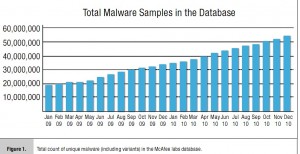The Key Capabilities to Embedded Device
In this fast development industry, there are several key points to realize success in electronic industry, as shown in the below: security, virtualization, connectivity, manageability, energy efficiency, sensing and analytics, workload consolidation, and interoperability.
Security
The security is becoming a factor that people concern the most. In real life, people have a lot of password to ensure the security. However, as the come out of imbedded internet and devices, it is becoming an obvious target for malicious attacks. And what’s worse, it is becoming more easily to be attacked. The McAfee Threats Report in the below figure: Fourth Quarter 2010 states that the identification of new malware went from 16,000 per day in 2007 to 60,000 per day in 2010. In fact, McAfee’s collection of malware samples soared to more than 50 million in 2010 (see Figure 1). With more and more embedded devices coming online, this more than signals the need for the same comprehensive security as found in the PC ecosystem.
Virtualization
Connected embedded devices may be called as both real-time and non-real-time operating systems (OSs), display riches user interfaces and process both critical and non-critical code in a large degree. Virtualization is a technique that enables multiple OSs to run on the same hardware. It makes it easier to meet these demands. Virtualization has the following features:
Consolidate legacy applications and OSs onto new platforms
Connecting a real-time operating system (RTOS) and a general-purpose operating system (GPOS) onto a single platform, while maintaining the responsiveness needed for real-time performance
Separate performance- or security-critical applications from less-critical applications.
Connectivity and Manageability
Always-on connectivity is quite important to realizing the function of changing existing applications and creating entirely new device categories, especially in applications of lever-age machine-to-machine (M2M) computing.
With the expanding of IP-connected embedded devices, end customers have new opportunities for cost-effective remote device management. Remote management can significantly reduce downtime, improve security, cut power consumption, trim staffing costs, and decrease IT costs by reducing truck rolls.
Energy Efficiency
Selecting a platform for an embedded design involves balancing processing requirements against power issues. Depending on the intended usage, the power criteria may include thermal limits, performance per watt per dollar targets or performance per cubic inch targets. Intel advancements enable IA processors to become more powerful each year while keeping energy consumption down, allowing IA processors to address critical power requirements.
Sensing and Analytics
Cameras and other sensors play a key role in embedded application segments from medical monitoring to transportation, factory automation, digital signage, and energy management. But simply capturing sensor data is not enough—advanced analytics are needed to turn the flood of data into coherent, actionable information. What’s more, many applications involve evolving scenarios, calling for software-based analytics that can meet changing requirements.
Workload Consolidation
Traditionally, network elements have run different workloads on different hardware architectures, such as packet processing on network processors, and control and application processing on general-purpose processors. That’s all changed now because of instruction-set enhancements optimized software libraries and continuing performance.
Interoperability
Interoperability is crucial to connected embedded devices. From a development perspective, software compatibility can greatly reduce development time and enable greater code re-use. From the end-user perspective, interoperability is the key to enabling devices to work together. For instance, the medical field is a major source of innovation for patient monitoring devices, peripheral devices, and electronic medical record-keeping systems, but the ultimate success of these devices depends on them working together in familiar ways.

